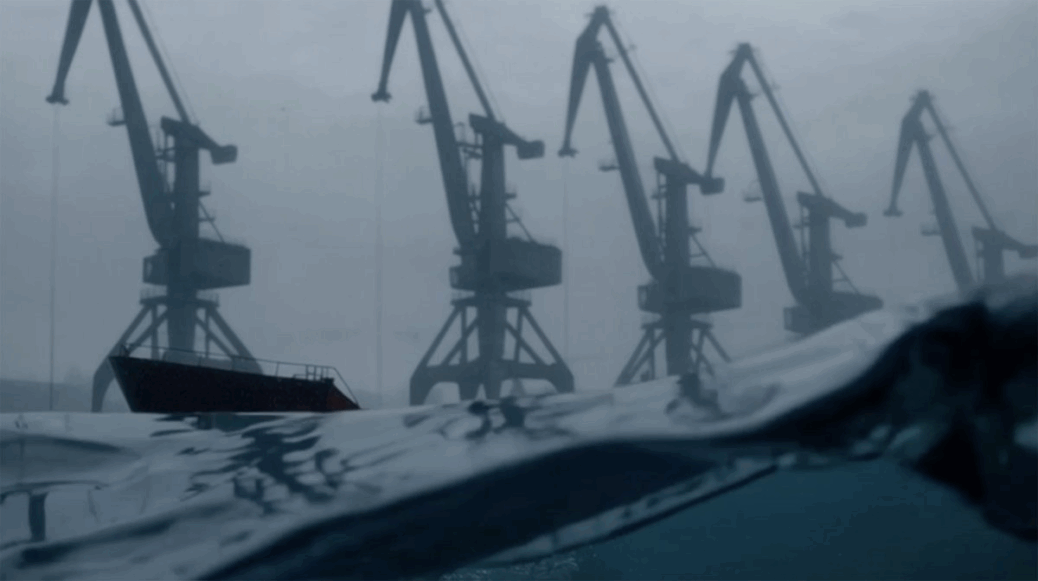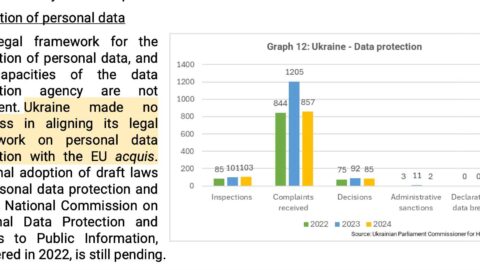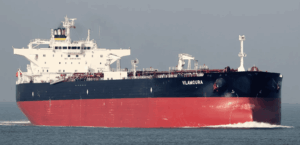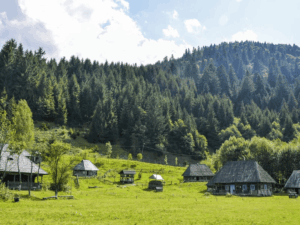Pirates of the Azov Sea: How the Russians Steal Ukrainian Grain with the Assistance of the Danish Company Baltic Control.
Assisted in conducting an investigation into the theft of 420.6 thousand tonnes of grain from occupied Berdiansk. The authors identified 20 vessels that carried out 85 voyages during the 2024–2025 period.
KibOrg News investigates.
Over the past year and a half, Russian occupiers have transported by sea from Berdiansk over 400,000 tonnes of Ukrainian grain and other agricultural products, with an estimated value of around 4 billion hryvnias.
Journalists from KibOrg and NGL.media gained access to internal documents of the Berdiansk port and verified about 20 vessels involved in the illegal grain export, as well as identified the individuals implementing this scheme—some of whom still remain Ukrainian citizens.
Located on the coast of the Azov Sea and occupied by Russian forces in March 2022, the port of Berdiansk has become a key link in the system of illegal trade in Ukrainian grain.
Journalists from KibOrg and NGL.media gained access to internal documents of the Berdiansk port and verified about 20 vessels involved in the illegal grain export. We also identified the captains of these ships, some of whom hold Ukrainian citizenship.
To falsify the origin of the grain, it is registered as Russian in the ports of Temryuk and Kavkaz, located in the Krasnodar region.
According to the documents, the Russians then export this grain to Turkey, Egypt, Libya, Lebanon, Saudi Arabia, Syria, and Bangladesh. In this way, they have managed to legalize over 400,000 tonnes of stolen Ukrainian grain on the international market.
The Danish company Baltic Control helps circumvent the ban on trading grain illegally exported from Ukraine. Journalists from KibOrg and NGL.media found evidence that Baltic Control’s division in Novorossiysk provides services to the Russian shadow fleet.
Occupation and the first strike
The port of Berdiansk came under Russian military control at the very beginning of Russia’s full-scale invasion of Ukraine. Starting March 14, 2022, the occupiers used the port to support military operations—particularly the siege of Mariupol.
At that time, the Russians announced the arrival of landing ships, calling it a “landmark event that would open logistical opportunities for the Black Sea Fleet.” However, on March 24, Ukrainian forces launched a missile strike on the large landing ship Saratov.

The port resumed operations on June 30, 2022, but by then it had become an additional center for exporting Ukrainian agricultural products. At that time, over 100,000 tonnes of grain were stored in Berdiansk, said Olha Saminina, who managed the State Enterprise “Berdiansk Commercial Sea Port” until the Russians captured the port and the city.
“Before the occupation, we had about 40,000 tonnes of grain in our warehouses, and around 80,000 tonnes of grain in private client warehouses in Berdiansk,” Saminina clarified. “They [the Russian military] looted everything they saw, including documents.”
Scale of the operation: What the occupiers are after
Even before the full-scale invasion, grain transshipment volumes at the Berdiansk port had been declining for several years. The main reason was the construction of the bridge across the Kerch Strait (also known as the “Crimean Bridge”) by Russia, which was opened in May 2018.
“After the ‘Crimean Bridge’ was built, [the Russians] introduced restrictions on the height of vessels — this cut off part of the fleet that used to enter Ukrainian ports,” explains Kateryna Yaresko, a journalist for the SeaKrime project. “They did this specifically to limit Ukraine’s economic capabilities.”
Additionally, according to Yaresko, the Russians delayed ships heading to and from Berdiansk and Mariupol for several days during border inspections. The SeaKrime journalist notes that this significantly increased freight costs, leading many shipowners to redirect to Ukrainian ports on the Black Sea.
After the occupation of Berdiansk, the Russians released the first data on the port’s cargo turnover only in May 2024. According to the occupation Ministry of Transport of Zaporizhzhia region, in 2023 the Berdiansk port handled 244,000 tonnes of goods. At that time, the Russian-appointed port director, Volodymyr Stelmachenko, forecasted a doubling of cargo turnover in 2024: according to his plans, the figures were expected to reach 500,000 tonnes — a level the port last showed back in 2019. Stelmachenko named foreign sanctions as the main obstacle to increasing the port’s cargo turnover: “In particular, shipowners, without whom our port cannot operate, are very vulnerable to sanctions.”
The Russians do not hide that they are mainly exporting grain from Berdiansk. In June 2024, this was confirmed by the then-head of the occupation government of Zaporizhzhia region, Iryna Hecht:
“Currently, our main cargo is grain, which is being sent to countries in Africa and others. This year, shipments went to Serbia, Turkey, Bangladesh, and Venezuela.”
A month earlier, representatives of the regional occupation administration announced the restoration of operations at six berths of the Berdiansk port. This information is confirmed by internal documents of the occupied port, which journalists from KibOrg and NGL.media obtained access to.
According to the documents from the occupation administration of the Azov Sea maritime ports, the allowable draft for vessels entering the port ranges from 6.9 to 7.2 meters, which is significantly deeper than the depths in Russian ports on the Azov Sea. For example, the port of Rostov-on-Don accepts ships with a maximum draft of 4.1 meters.

Logistics schemes: How the origin of the grain is hidden
Ships loaded with Ukrainian grain from Berdiansk mainly transit through the Russian ports of Temryuk and Kavkaz. There, the Russians legalize the stolen grain—offering it on the international market as purely Russian.
“If a port doesn’t have a customs office [like in Berdiansk], the voyage is registered as cabotage, and the ship docks at a port where all the services are available,” explains Kateryna Yaresko from SeaKrime. “The Russians prepare documents indicating that the port of shipment is Temryuk or Kavkaz. This way, information that the grain was actually loaded in Berdiansk is concealed.”
At the end of 2024, the occupation “governor” of the seized part of Zaporizhzhia region, Yevhen Balytskyi, spoke about the need to establish a customs post directly in Berdiansk.
On one hand, introducing customs there would allow the occupiers to export Ukrainian agricultural products faster, while on the other hand, it would formally legalize this process.
At the beginning of 2025, Andriy Belyayev, head of Russia’s Southern Customs Directorate, stated that the port infrastructure in Berdiansk is ready to accommodate Russian customs officers. He also announced plans to restore customs infrastructure facilities in the occupied cities of Berdiansk, Melitopol, and Skadovsk.
Key players: Who profits from the theft
We managed to obtain access to documents on ship arrivals at Berdiansk port during 2024–2025 and verified 20 vessels that collectively completed 85 voyages. According to the documents, the grain was exported to countries including Turkey, Egypt, Libya, Lebanon, Syria, Saudi Arabia, and Bangladesh.
The same documents indicate that the total amount of agricultural products taken by the occupiers from Berdiansk port during this period exceeds 420.6 thousand tons.
The most frequent users of the Berdyansk port services were three Russian companies:
- Lipetsk-based LLC “Bars” with a revenue of about 16.4 billion rubles in 2024;
- Crimean LLC “Selectagro” with a revenue of 3.4 billion rubles;
- Moscow-based JSC “First Trading Company” with 1.2 billion rubles in revenue.
Occasionally, vessels servicing the interests of other companies were also recorded in the port, including LLC “GRACE,” LLC “Agora,” LLC “Terra Trade Company,” LLC “Element Agro,” and LLC “Makoveja.”
Most of the ships entering Berdyansk over the past year and a half have been subject to US sanctions since May 2022. However, some vessels have not yet fallen under sanctions, including:
- “Victoria K” and “Victoria V,” both of which frequently visited Berdyansk port and, in January 2025, transported Ukrainian coal from Mariupol;
- “Kapitan Yakovlev,” “Kapitan Mironov,” and “Sormovsky 48,” which have repeatedly been spotted by Ukrainian and international media in occupied Ukrainian ports over the last three years.
Routes of Russian ships
The map shows schematic routes of Russian vessels that transported grain from Berdyansk. Use the filters to search for specific ships or routes. Click on a route line to get detailed information about the voyage, or click on a port to see all voyages that passed through it.

Who coordinates the grain export from Berdyansk?
The main logistics operator of Berdyansk port is the company Kristall-2019, founded six years ago in Simferopol. Until 2023, the company had no employees and conducted no economic activity, but at the beginning of 2024 it changed its registration address to Berdyansk (25 Horkoho Street). Ultimately, 2024 brought the company revenues of one billion rubles.
70% of the company is owned by Olena Polevaya, a native of Kyiv who received a Russian passport after the occupation of Crimea. Several other companies she owns are also located on the peninsula, but none have been as successful as Kristall-2019.

The company’s general director is Russian citizen Sergiy Glebov, who previously lived in Volgograd. Russia’s border‑crossing database shows that in 2022 he made several trips to the occupied territories of Kherson, Donetsk, and Zaporizhzhia regions. In June 2023 he took charge of Kristall‑2019, and a month later—according to the Russian Pension Fund—he was appointed “Deputy Director for Legal Affairs” of the Berdyansk Commercial Sea Port. He still holds positions at both entities.

That same summer of 2023, Kristall‑2019 began operating in the Berdyansk port.
“The establishment of partnership relations between our organisations has naturally produced synergy, resulting in a substantial increase in the volume of cargo handled through the Berdyansk port,” wrote the company’s then‑executive director V.I. Kornilyev in a letter to the occupation-appointed port manager, Volodymyr Stelmachenko.
In addition, the company proposed to Stelmachenko the creation of a grain inspection laboratory at the port, which was intended to speed up the analysis of products destined for export.
Kristall-2019 periodically reported to Stelmachenko about its planned cargo handling volumes. In November 2023, the company aimed to load nearly 100,000 tonnes by the end of the year. For 2024, it targeted 400,000 tonnes, and this year it also plans to handle around 400,000 tonnes of cargo.
According to a March 2024 letter from Yuriy A. Panfilov, Acting Captain of the Berdyansk Seaport, Kristall‑2019 LLC was the only logistics company operating directly at the port and the only one invited to working meetings.
Captains of pirate vessels
Journalists from KibOrg and NGL.media managed to identify 34 captains of vessels that illegally exported goods from the occupied port. Seven of them still hold Ukrainian citizenship.
For example, 48-year-old Crimean Serhii Ryzhov entered Berdyansk six times aboard the vessel Sofiia. Another Crimean native, 55-year-old Vadym Honcharov, holds the record among the identified captains — during 2024–2025, he made 13 illegal entries into Berdyansk on the ship Nadezhda.
Three years ago, Honcharov began working for Kuban Maritime Company LLC and primarily sails to Turkish ports.
Most of the captains are not public figures, but the information we were able to gather shows that some have already faced issues in their professional careers — particularly due to their collaboration with the occupiers.
For instance, 57-year-old Russian national Oleksandr Oleynikov sailed the vessel Alpha M in October 2024 along the route Berdyansk–Kavkaz–Egypt.
Two years earlier, he was detained along with the dry cargo ship Viktor Andryukhin in the French port of Fos-sur-Mer. The vessel was leased by the Russian company Alfa LLC, which has ties to PJSC GTLK — the State Transport Leasing Company. GTLK presents itself as Russia’s largest leasing enterprise specializing in aviation, maritime, railway, and urban passenger transport. It is subordinated to the Russian government and is considered strategically important for the Russian economy.
On February 28, 2022, while the Viktor Andryukhin was docked at a French port, the EU imposed sanctions on PJSC GTLK, which enabled the vessel’s detention. At the time, Oleynikov complained about alleged harassment and attacks against Russians.
“I know that in some ports, Ukrainian sailors become aggressive when they see their Russian colleagues — throwing tomatoes and such. We can’t do the same. It’s beneath the dignity of a Russian seaman,” the captain said.
Before 2022, Oleynikov frequently sailed to European ports, but after Russia’s full-scale invasion of Ukraine, vessels owned by Alfa LLC — which Oleynikov has captained since 2021 — were no longer welcome in Europe. Since then, he has primarily sailed to Turkish and Abkhazian ports.
Another captain about whom more information was found is 45-year-old Nikolay Timofeyev, who in September 2024 sailed the route Berdiansk–Temryuk–Beirut aboard the Viktoria K. Back in 2017, Timofeyev — then the chief mate of the Merle — was detained and spent several months in a Libyan prison after the vessel was seized on suspicion of smuggling.
Since the start of Russia’s full-scale invasion, Timofeyev has entered ports in Romania, Turkey, Egypt, and Iran.
Earlier, KibOrg journalists revealed that captains of ships entering Berdiansk intentionally disable their AIS transponders when approaching the occupied port. This tactic prevents their movements from being recorded by independent vessel tracking systems, which collect data on port calls and shipping routes.
Captains of Russian Vessels




Baltic Control: A Danish company serving the Russians
The Danes at Baltic Control describe themselves as a leading international company providing surveying services. At the beginning of 2023, A/S Baltic Control Group Ltd. was acquired by the French company Apave Group, which has specialized in risk management for over 150 years. At that time, Baltic Control already had 53 branches worldwide — including one in Odesa, and at least until October 2022, one in Novorossiysk as well. In 2023, the record of an office in Russia disappeared from the company’s website, although there was no official announcement about Baltic Control’s exit from the Russian market.
On Baltic Control’s main website, the address of the Russian branch is listed as 79 Admiral Serebryakov Street, Office 5, Novorossiysk. However, a Baltic Control branch at this address has never existed in Russia. Instead, if you check the archive of the Baltic Control Russia website via Wayback Machine, you can see that the Novorossiysk branch was legally registered at 1 Gorodskaya Street. Additionally, the contact emails on the Danish main site and the Russian branch site match.
LLC “Baltic Control Novorossiysk” was established in 2013. Over the past three years, the company has continued operating in Russia and earned nearly 370 million rubles last year.
According to internal documents from the Berdyansk port, Russian companies active there frequently use the services of Baltic Control. For example, during the nomination of the vessel “Leonid Pestrikov” for the Berdyansk–Caucasus–Egypt route in March 2025, one of the key conditions was the mandatory “inspection of the holds by the independent surveying company Baltic Control.” Journalists from KibOrg and Slidstvo.Info confirmed that this refers to the Russian branch of the same Danish company Baltic Control.
“This case clearly highlights the gaps that currently exist in communication with Ukraine’s international partners,” says Kateryna Rashevska, a lawyer at the Regional Human Rights Center. “According to President Volodymyr Zelenskyy, Denmark is one of the leaders in supporting our country. However, private entities continue to cooperate with the aggressor state, violating Ukrainian law and international law. The policy of non-recognition, which all states are obliged to follow in the context of aggression against another state, specifically includes informing their own citizens about the prohibition of cooperating with the occupying state in the occupied territories. Private entities also have a responsibility to avoid causing harm and not to participate in activities that support occupation and/or human rights violations.”
Journalists sent a request to the Baltic Control headquarters asking for a comment, but as of the time of publication, no response had been received.
Tags: azov grain investigation news Russia russia ukraine war russian aggression. sea of Azov sea of Azov Ukraine war war in ukraine latest news war news



























